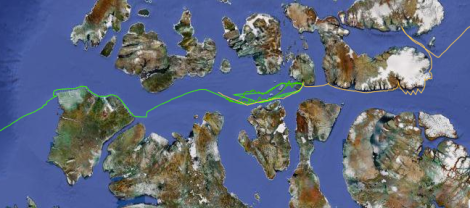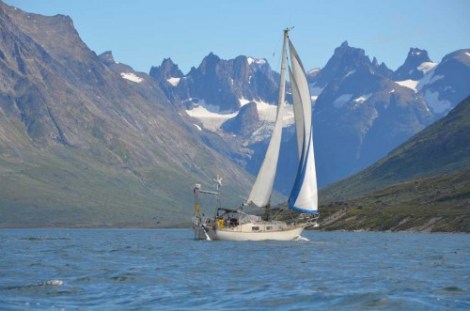Two weeks ago, a Chinese icebreaker became the first vessel from that country to traverse the Canadian Arctic — the fabled Northwest passage, sailed in reverse. That success was thanks to rapidly melting ice in the region, but it still required an icebreaker.

The route of the Belzebub II.
On Monday, a group of three men reported that they completed the trip last week by sailboat, the Belzebub II. From the Los Angeles Times:
[L]ast week, scientists said the area of floating sea ice in the Arctic had fallen to the lowest level ever observed. As the Belzebub II lingered in the Prince of Wales Strait, its crew — which includes Morgan Peissel, a Boston native and an assistant to filmmaker Errol Morris — received the message from Canadian ice-watching officials that set them in motion: “Good afternoon. It’s not recommended to go into M’Clure Strait, but there is a window open north of Banks. There is a lead developing all along the North shore of Banks Island.”
The ice would return soon, but the decision to go was made “in a heartbeat,” the crew said Monday in a blog post. The Belzebub II then swam into the dangerous strait as walls of ice surrounded the small sailboat, the crew uncertain of whether the ship could make the passage. …
Twenty-four hours into the attempt, going without any sleep, the explorers said they got word that walls of ice were closing the passageway behind them. They hurried ahead, and their craft knifed through clear waters for another 12 hours and finally brought them to their destination just beyond the strait on Wednesday.
Footage of the sailors taken by Canadian Ice Services.
The strait is named for Robert McClure, the first man to traverse the Northwest Passage using a combination of ships and over-ice sleds in 1854.
In a blog post announcing the successful trip, the crew notes that they weren’t the first non-commercial vessel to make it through: a motor boat piloted by mariner David Cowper beat them by a few hours.

The Belzebub II.
Hat tip: Boing Boing.



